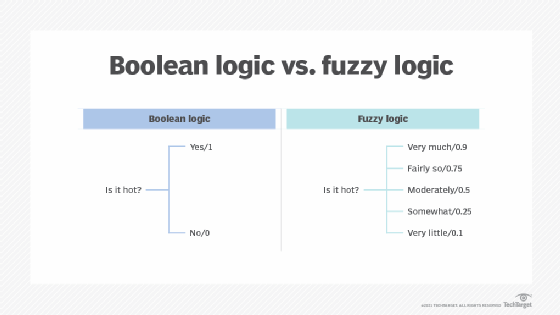logical OR symbol
What is the logical OR symbol?
In mathematics, the logical OR symbol is a Boolean function that is positioned between two statements to indicate an inclusive disjunction between them. An inclusive disjunction is a condition that evaluates if one or both statements are true. The OR symbol is typically represented by a descending wedge (∨), derived from the Latin word vel, meaning or. Sometimes, the OR symbol is represented by a plus sign (+) or vertical bar (|).
The OR symbol has its roots in Boolean algebra, a field of mathematics concerned with the logical relationship between statements in an expression. Each statement in the expression returns a truth value of either true or false -- 1 or 0, respectively. Boolean algebra is based on the works of the English mathematician George Boole (1815-1864).
In Boolean algebra, the OR symbol is a type of connective function. A connective function is one that links statements in an expression together and evaluates them according to specific logic. The function determines the statements' truth values and returns a single truth value based on that evaluation.

When an expression with two statements includes an OR function, the function returns a true value if either statement is true or if both statements are true, but it returns a false value if both statements are false. For example, if variable A represents the statement "It is raining" and variable B represents the statement "It is snowing," then the expression A ∨ B represents the sentence "It is raining or snowing, or it is doing both." If either of these conditions are met, the statement is true. If it is not raining and it is not snowing, the sentence is false.
Notice that the meaning of the OR function is slightly different from its or counterpart in written communication, as it is used in a compound sentence. For instance, the sentence "It is raining or it is snowing" implies that only one of these two events is occurring. However, when the OR symbol is used as a connective function in an algebraic expression, it is possible for both statements to be true. To achieve the same logic in a regular sentence, it must be specifically stated that both events are possible by adding a clause such as "or it is doing both."
The logic of the expression A ∨ B can be mapped on a truth table, which is a tabular representation of the possible combinations of the variables' truth values and the function's output. Truth tables often use T and F to represent true and false, although 1 and 0 are also used. This table, which uses T and F, includes one column for each variable (A and B) and one column for the expression's output (A ∨ B).
| A | B | A ∨ B |
| T |
T |
T |
| T |
F |
T |
| F |
T |
T |
| F |
F |
F |
The truth table shows that the expression A ∨ B is true in all cases except when the truth values for both A and B are false. In the original statements -- where A represents "It is raining" and B represents "It is snowing" -- we can conclude the following facts in the truth table:
- If it is raining and snowing, the sentence evaluates to true.
- If it is raining but not snowing, the sentence evaluates to true.
- If it is not raining but it is snowing, the sentence evaluates to true.
- If it is not raining and it is not snowing, the sentence evaluates to false.
When working with the OR symbol -- or any of the connective functions -- there can be more than two statements in an expression. For example, if the C variable represents the statement "It is sleeting," the expression might be modified to A ∨ B ∨ C, in which case the truth table contains an additional column and four additional rows to accommodate all the possible truth value combinations.
| A | B | C | A ∨ B ∨ C |
| T | T | T | T |
| T | T | F | T |
| T | F | T | T |
| T | F | F | T |
| F | T | T | T |
| F | T | F | T |
| F | F | T | T |
| F | F | F | F |
Like the previous example, the truth table shows that the expression A ∨ B ∨ C is true in all cases except when the truth values for A, B and C are all false. As a result, the following facts can be concluded on the truth table:
- If it is raining, snowing and sleeting, the sentence evaluates to true.
- If it is raining and snowing but not sleeting, the sentence evaluates to true.
- If it is raining and sleeting but not snowing, the sentence evaluates to true.
- If it is raining but not snowing or sleeting, the sentence evaluates to true.
- If it is not raining but it is snowing and sleeting, the sentence evaluates to true.
- If it is not raining or sleeting but it is snowing, the sentence evaluates to true.
- If it is not raining or snowing but it is sleeting, the sentence evaluates to true.
- If it is not raining, snowing or sleeting, the sentence evaluates to false.
The OR symbol and the AND symbol
The OR symbol is often contrasted with the AND symbol, another type of connective function. The AND symbol is referred to as a logical conjunction, in contrast to the OR symbol, which is referred to as a logical inclusive disjunction. The AND symbol is typically represented by the ascending wedge (∧) and is sometimes represented by an asterisk (*) or a dot (⋅).
When the AND symbol is used in an expression with two statements, both statements must be true for the function to return a value of true. In the expression A ∧ B, for example, both A and B must both be true for the expression to evaluate to true, as shown in the truth table.
| A | B | A ∧ B |
| T |
T |
T |
| T |
F |
F |
| F |
T |
F |
| F |
F |
F |
Because the expression uses the AND symbol rather than the OR symbol, the results differ from when the A ∨ B expression is used:
- If it is raining and snowing, the sentence evaluates to true.
- If it is raining but not snowing, the sentence evaluates to false.
- If it is not raining but it is snowing, the sentence evaluates to false.
- If it is not raining and it is not snowing, the sentence evaluates to false.
Connective functions can be combined to create more complex expressions. For example, the expression A ∨ B ∧ C includes both the OR symbol and the AND symbol. When both symbols are used in the same expression, the AND function takes precedence over the OR function unless parentheses are used to change the logic.
Even if parentheses are not needed, using them can make an expression easier to understand. For example, A ∨ B ∧ C can be recast to A ∨ (B ∧ C) without changing its meaning. Expressions that contain different connective functions can also be mapped out in a truth table.
| A | B | C | A ∨ (B ∧ C) |
| T | T | T | T |
| T | T | F | T |
| T | F | T | T |
| T | F | F | T |
| F | T | T | T |
| F | T | F | F |
| F | F | T | F |
| F | F | F | F |
As the truth table indicates, the expression's results are like those returned by the expression A ∨ B ∨ C, with two notable exceptions:
- If it is not raining or sleeting but it is snowing, the sentence evaluates to false.
- If it is not raining or snowing but it is sleeting, the sentence evaluates to false.
The expression returns a true value only if the truth value for A is true, the truth values for both B and C are true or the truth values for all three variables are true.
The OR symbol and the NOT symbol
Another important connective function is the NOT symbol. Also referred to as a logical negation, it is typically represented by a dash and tail that precede the variable, as in ¬x. The NOT symbol might also be represented by an overline above the variable (x̅), a tilde preceding the variable (~x), an exclamation mark preceding the variable (!x) or a single quote following the variable (x').
The NOT function returns true when a variable is false and returns false when a variable is true. As with the AND symbol and OR symbol, the NOT symbol can be used with other connective functions in the same expression, as in A ∨ B ∧ ¬C.
According to the rules of precedence, the NOT function is evaluated before the AND function, which is evaluated before the OR function, so the expression can be rewritten as A ∨ (B ∧ ¬C) or A ∨ (B ∧ (¬C)). Like the expressions shown in the earlier examples, this one can also be mapped out in a truth table.
| A | B | C | A ∨ (B ∨ ¬C) |
| T | T | T | T |
| T | T | F | T |
| T | F | T | T |
| T | F | F | T |
| F | T | T | F |
| F | T | F | T |
| F | F | T | F |
| F | F | F | F |
As the table shows, the expression returns a true value only if A is true, B is true and C is false or if all three variables are true.
See also: logic gate and mathematical symbols.
